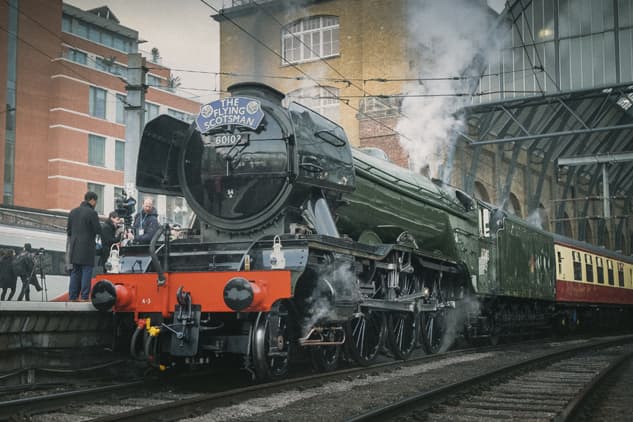When I was ten, my dad took me to see the ‘world-famous’ steam locomotive, the Flying Scotsman. Over the past few years I’ve been following this icon’s painstaking restoration to full working order by hoping that one day I might just get the chance to photograph it in all its glory and relive my days as a youngster.
There are opportunities in life that you just can’t let pass by, and when I discovered that, for its inaugural run, the restored steam train would depart the nation’s capital at Kings Cross and run along its old stomping ground, to York, it made me think about how best to capture it, and where best to shoot it.
An image search on the internet for inspiration around the London area revealed a striking photograph on the National Railway Museum’s website of the Flying Scotsman ready to depart Kings Cross for Doncaster, where it was originally built in 1923. The image jumped out from the others for a number of reasons. I loved its classic film aesthetic – it was a simple, yet well-composed front three-quarter shot and portrayed the engine in a way that I could visualise it looking at the end of Kings Cross station today, albeit with overhead wires.

Image Credit: National Railway Museum/Science & Society Picture Library. A3 class 4-6-2 locomotive number 60103 Flying Scotsman at King’s Cross station, 1963.
After some research, I discovered the Flying Scotsman was to be out-shopped in the identical British Railways livery as illustrated in the 1963 photograph, and it was this that influenced my final decision to attempt to recreate the same shot.
With so much doom and gloom about British manufacturing and production, the thought of capturing a similar image of the same subject at the same location 53 years down the line seemed a fitting way to celebrate the return of an exemplary icon to the rails, and illustrate some of the best of past British engineering.
A few weeks later, on Thursday 25 February, I got my chance. An early start got me to Kings Cross station for 6.45am, and with half an hour before the locomotive was due to back into Platform 1 to pick up its passengers, I grabbed a quick coffee and purchased the cheapest return ticket I could to get past the ticket barriers.

Hordes of enthusiasts and photographers lined up at Kings Cross to get a glimpse of the Flying Scotsman
After walking the full length of Platform 2 to take up my position, my heart sank. A Virgin train had parked directly opposite where the Flying Scotsman was expected to stop. It ruined any chance to take the photograph I imagined might be possible. Disgruntled that my journey seemed wasted, I turned to get whatever shot I could as the Flying Scotsman, resplendent in its fresh green paint, gently rolled in to the station – to the delight of the many onlookers.
Establishing that my initial position was all wrong, I gave up my vantage point and moved further along the crowded platform in an attempt to position myself lower down and much closer to the platform edge. I ended up nestled between a group of photographers’ feet and, as I raised my camera to my eye, the station staff around me warned onlookers of the imminent departure of the Virgin train that, up until now had been blocking my shot. Finger on the shutter, this was my chance.

Initially, the perspective of the image was wrong and the view was spoilt by an adjacent Virgin train
A few seconds later, I was presented with the magnificent sight of the Flying Scotsman at the head of its express under the Kings Cross station canopy, and it seemed like I might be able to recreate the shot from 1963 after all. With my arm outstretched, I fired off countless frames just hoping that I’d get what I was after. But pulling a print of the 1963 photograph from my pocket and comparing it to the shot on my screen, revealed I was shooting from too high an angle. Lowering the camera to just below platform level instantly improved the perspective.
The final shot, shown here, was captured a fraction of a second before there was a peep from the whistle and a surge of steam. The Flying Scotsman had begun its memorable journey north.

Image Credit: Michael Topham. A3 class 4-6-2 locomotive number 60103 Flying Scotsman at King’s Cross station, 2016. To recreate a similar feel to the original image, a combination of VSCO film presets were applied in Lightroom, before tweaking the levels, curves and Colour Balance in Photoshop.
I feel incredibly privileged and fortunate to have been one of the few hundred on the platform to witness such a spectacle. If you get the chance to see the Flying Scotsman on tour this summer, I urge you to do so. It’s an awe-inspiring sight which will leave you feeling very proud to be British.
Flying Scotsman on Tour
Having completed its inaugural run in fine style, the Flying Scotsman will soon embark on its tour of the UK, running the length and breadth of the country (Scotsman On The Tracks, 12 March to 25 September).

The National Railway Museum, which saved the steam icon in 2004 and put it through its extensive £4.2-million restoration, is currently showcasing an exhilarating exhibition, Starring Scotsman, in York until 19 June, with opportunities to see the iconic locomotive on display when it’s not busy hauling trains around the country.
For those who’d like to see Flying Scotsman lined up in the National Railway Museum’s impressive Great Hall alongside three other locomotives that hauled the famous Flying Scotsman passenger train there will also be a special Stunts, Speed and Style event running from March 25th 2016 to May 8th 2016. More information can be found by visiting the Stunts, Speed and Style events page and there will be the opportunity to get exclusive access to photograph the Flying Scotsman in the museum without the crowds on 1, 11, 15, 20, and 30 April between 8am and 9:45am. (Tickets cost £15 per person and more information can be found here)
For more information about the National Railway Museum’s Flying Scotsman season visit www.nrm.org.uk/flyingscotsman/scotsman-season, or follow Twitter at #FlyingScotsman.







